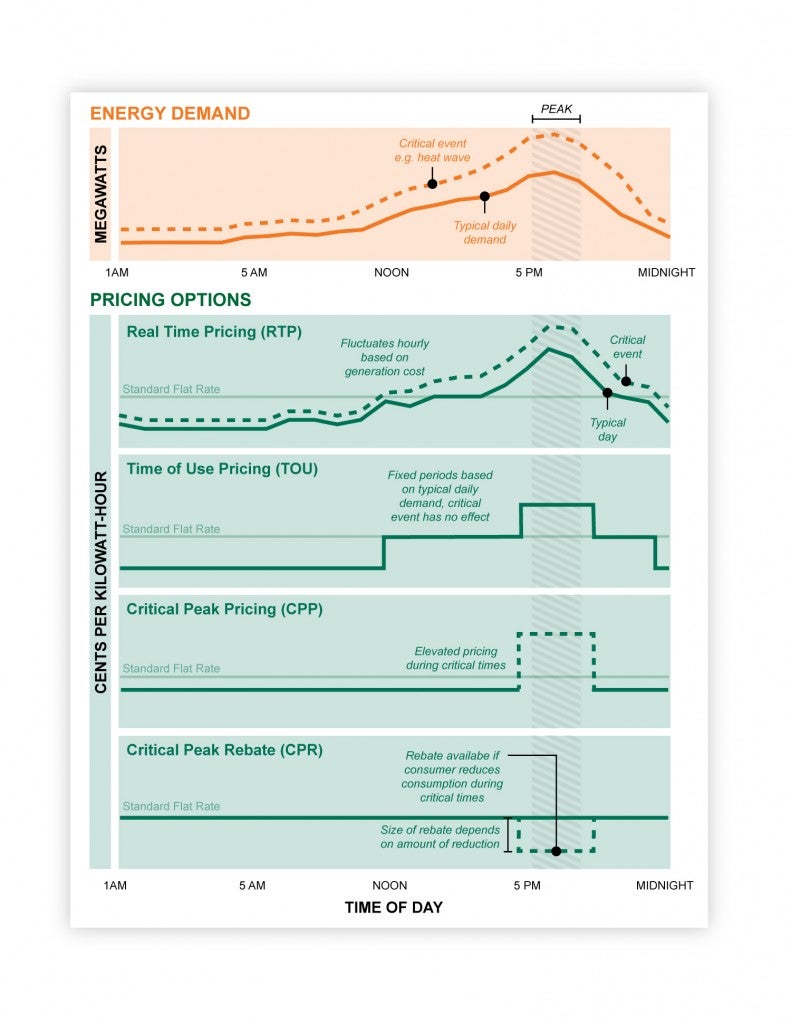 In the U.S., the electricity sector accounts for over a third of the country’s yearly greenhouse gas emissions, contributing more to climate change than any other sector, including transportation.
In the U.S., the electricity sector accounts for over a third of the country’s yearly greenhouse gas emissions, contributing more to climate change than any other sector, including transportation.
Furthermore, electricity costs have increased dramatically over the years, and are projected to continue their upward trend. Utilities and regulators have made great strides in promoting renewable energy, increasing the efficiency of the power grid, and reducing harmful pollution. However, customers, too, can be part of the solution by better managing their use of electricity – especially during those times when it is most expensive and dirty to produce.
Electricity is more expensive during ‘critical peaks’
The cost of producing electricity – and the carbon emissions associated with it – varies significantly throughout the day, depending on electricity demand at any point in time. For example, when a heat wave occurs and many customers begin cooling their homes after work, demand skyrockets and creates what is known as a ‘critical peak.’
In order to meet this increased demand, the most expensive power plants – which remain unused for most of the year and generally tend to emit more pollution – are turned on. Enabling customers to curb their electricity use during these heat waves could offset the need for these dirty, expensive plants, resulting in lower prices and less harmful pollution. Customers could, for example, set their air conditioner at a temperature a few degrees warmer or run large appliances such as dishwashers, washing machines, and dryers outside of the times most people are using electricity.
[Tweet “The dirty secret about electricity: it’s cheaper and cleaner by time of day www.edf.org/cQq “]
Unfortunately, most customers aren’t provided with information on when these critical times occur and have little to no incentive to curb their demand during these times because they are neither rewarded for doing so, nor penalized when they don’t. Instead, they pay the same price for electricity used at all times of day, irrespective of heat waves or other periods of high electricity demand.
Time-variant electricity pricing
Many utilities have begun to realize that this type of pricing is hardly efficient. Pricing electricity in a way that reflects its true cost can help utilities reduce overall costs and pass these lower prices onto customers. For example, utilities can charge customers different rates at different times of the day or throughout the month – this is known as ‘time-variant electricity pricing’.
This type of pricing allows customers to have greater control over their electricity bill. By reducing electricity use during times when it’s more expensive to produce, they can take advantage of cheaper electricity being offered at other times. Furthermore, environmentally-conscious customers can reduce their carbon emissions by timing their electricity use. Essentially, time-variant pricing empowers electricity customers by bringing them into the market and allowing them to affect it with their behavior: if we would all shift away from periods of high demand, electricity prices would fall for everyone.
Below are several different types of time-variant electricity pricing:
- Real-time pricing (RTP) – In this type of pricing, electricity rates vary frequently over the course of the day. Rates change over very short intervals – such as an hour – and the customer receives a unique price signal for each interval, reflecting the costs of generating electricity during that time. Generally, this type of pricing is used for larger commercial customers, who are better suited to respond to such high price variability. They may, for example, use technologies that turn off machines when prices rise above a certain limit. In New York, large commercial customers face mandatory hourly pricing. However, two Illinois utilities, Commonwealth Edison and Ameren, have begun to implement RTP for residential customers. This type of pricing requires a smart meter, which provides detailed electricity use data throughout the day, allowing the utility to measure and record energy use during each hour.
- Time-of-use pricing (TOU) – The most commonly utilized form of time-variant pricing, TOU pricing breaks up the day into two or three large intervals and charges a different price for each. Rates can be divided into off-peak prices (generally during the middle of the night to early morning), semi-peak prices (daytime and evening), and peak prices (occurring during periods of highest demand, usually afternoon/early evening); these rates remain fixed day-to-day over the season. This simple method of pricing encourages customers to shift their electricity use away from times of the day when demand is higher. However, it does not necessarily encourage reduced electricity use during critical peak times over the year, such as during heat waves. Most utilities throughout the country have a voluntary TOU rate available to customers, although overall, adoption has remained low.
- Critical peak pricing (CPP) – With this type of pricing, customers receive a signal (such as an email, text, or phone call) advising them that the price of electricity will increase dramatically in the next day or even in coming hours. The customer can avoid paying high prices by reducing electricity use during these periods of high demand and benefit from a slightly lower, off-peak price relative to the flat rate. Critical peak pricing has been implemented by several utilities (for example, Oklahoma Gas &Electric, Sacramento Municipal Utility District, and Arizona Public Service) across the country, either through pilot programs or new rate structures, with high levels of success. In some pilot programs, customers reduced their electricity use during these critical peaks by as much as 50 percent when they had access to enabling technologies such as air conditioning units that automatically respond to price signals.
- Critical peak rebate (CPR) – Similar in nature to CPP, in this case, the utility pays the customer for each kilowatt hour of electricity they are able to reduce relative to the amount they normally use during critical peak times. These rebates have been rolled out or made available to all customers in Washington DC and Baltimore after exhibiting success in prior pilot programs.
As the above descriptions indicate, there are a number of sophisticated pricing programs that can better reflect the true cost of electricity. They can even be grouped together: for example, CPP and CPR rates can be layered on top of TOU rates, helping to combat the regular peaks that occur every day (when customers come home or when businesses are in full swing) while also dealing with the more rare critical peak moments, such as during heat waves.
Although time-variant electricity pricing is still not widely available across the country, more utilities and customers are waking up to the benefits of pricing electricity differently by time of day, month, and year and realizing that dynamic rate structures are integral to a cleaner, more efficient energy system.
For more information, check out our new time-variant pricing fact sheet.











3 Comments
Thanks for clear overview of the 4 pricing strategies. How are these prices communicated to customers? is pricing pushed out to customer or does customer pull the information into energy management system?
Pricing can be communicated to the customer in several ways. For time-of-use pricing, the prices faced by communicated to the customer in each time frame (peak, off-peak, semi-peak) is agreed upon before signing up and does not change within the year. For critical peak pricing, generally the critical peak price is also agreed upon beforehand. What needs to be communicated to the customer is the timing of the critical peak event. This can be achieved through an email, phone call, or text the day before or the day of the event (critical peak rebates work in the same manner). For real-time pricing, the price can be communicated to the customer in several ways. For example, the utility can post the hourly prices the day before or the day of on a customer-accessible website. Alternatively, the customer can own an in-home-display that shows the current price. Furthermore, smart thermostats can receive a signal from the utility which communicates that the price is high, allowing the air conditioner to be cycled off and on to reduce consumption during high-peak times.
The article does a fine job of describing the basic types of time-of-use / time-variant / dynamic pricing that have traditionally been offered by electric utilities. Success has been limited, probably because “charging me more just when I need my electricity” is not popular. Not mentioned in the article are the time-variant offers in Texas — the most vibrant competitive retail electric market in North America. There, you can find offers that fix the price for most hours of the week (“flat, stable pricing”) over a contract period (12 months). A small premium is paid in return for free electric service at specified times during the week. “Free Nights” (9:00 p.m. to 6:00 a.m.), “Free Saturdays” and “Free Weekends” are two popular options. By sending a clear pricing signal ($0.00) when power is low in cost, the retail electricity provider (REP) encourages consumers to change behavior and shift their usage. This makes serving that customer less expensive. (Each customer’s actual usage is calculated every 15 minutes to determine the cost to the REP to serve that customer.) Customers go after the “carrot” of “free electricity” rather than being beaten with the “stick” of high costs. “Free” sounds wasteful. It is not. In the competitive retail electricity market, willing buyers and sellers seek an economically efficient outcome. After 75 years of administered “prices” via the tariff, Texas is allowing REPs to see how best to acquire and retain customers through innovative pricing, technologies and services.